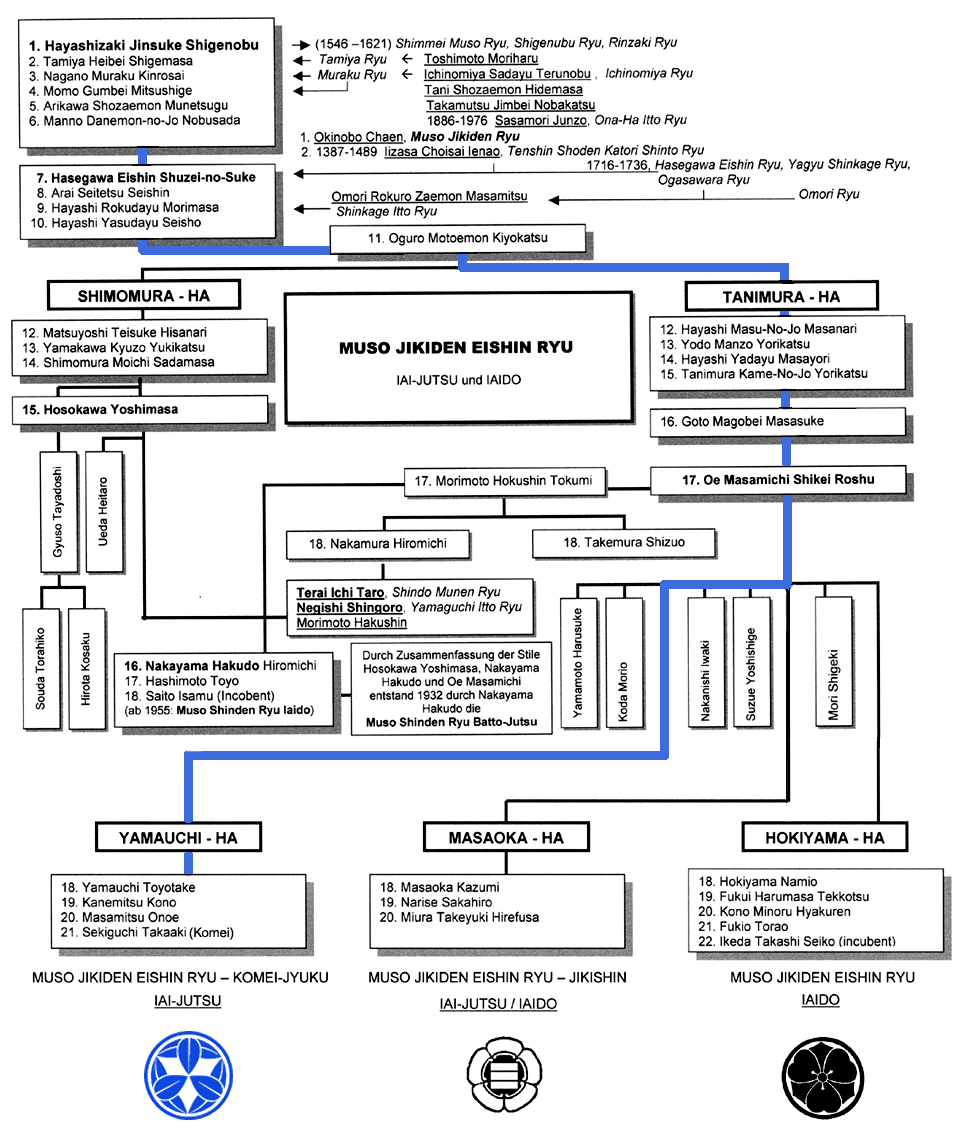|
EISHIN RYU IAIJUTSU
"Pearless, Direct Transmission,
True-Faith Style"
Musō Jikiden Eishin-ryū (無雙直傳英信流),
is a koryū sword art, and one of the most widely practiced schools
of iaijutsu in the world. Often referred to simply as "Eishin-ryū,"
it claims an unbroken lineage dating back to the sixteenth century.
The school takes its name from its seventh headmaster,
Hasegawa Chikaranosuke Hidenobu (長谷川主税助英信), who had founded Hasegawa Eishin-ryū. ‘Musō Jikiden Eishin-ryū’
means ‘peerless, directly transmitted school of Eishin.’ ‘Eishin’ is an alternative pronunciation
of ‘Hidenobu. This school
claims an unbroken history of about 450 years, making it one of the oldest extant martial arts in Japan.
 Our curriculum encompasses the practice of waza (prearranged
solo techniques), katachi or kumitachi (paired patterns using a wood sword or 'bokken'), and also tameshigiri (test cutting
using a live/sharp sword on targets). These components reinforce and improve each other to make the student aware
of proper body mechanics, focus, and technique for the effective use of the sword. All three of these, plus the integral observance
and practice of sincere etiquette make up the core curriculum of our Iaijutsu program.
 Iaijutsu (居合術), often translated roughly as the "art
of mental presence and immediate response", is the Japanese martial art of drawing the sword. At least one author makes the distinction that, strictly speaking,
iaijutsu consists exclusively of the portion of combat where the sword is drawn, and that any further techniques are technically
classified as kenjutsu.
It is unclear exactly when the term "iaijutsu" first came into
use, or when exactly drawing the katana from its scabbard first became practiced as a discrete martial art; however, Iaijutsu
was developed for the specific combative purpose of defending oneself, not on the battlefield, but in everyday life. A central
feature of iaijutsu is, therefore, drawing the sword from several traditional sitting postures, including seiza, iai-goshi,
and tate-hiza. Techniques from a standing posture (tachi-ai) are also studied. Additionally, with the emphasis
upon defense during daily life, it was also generally assumed that combatants would be armed with a katana worn "edge-up"
and thrust through a sash around the waist, and that combatants would be fighting unarmored. These assumptions result in a
drastically different approach to combat than when combatants are armored and fighting on the battlefield.
 This
school claims an unbroken history of about 450 years, making it one of the oldest extant martial arts in Japan. Eishin-ryū
uses a system of indiscriminate transmission (完全相傳), allowing anyone in possession of full-transmission
to award licenses to any number of his students. Therefore it is possible that there were multiple but unlisted holders of
menkyo kaiden, known in Eishin-ryū as Kongen no Maki (根元之巻), in any generation. Due also
in part to Ōe Masamichi’s more open and inclusive approach to teaching Eishin-ryū, the lineages of groups
currently practicing the art are fairly diverse and complex.
Following Kōno Hyakuren’s death, the lineage of Eishin-ryu
became contested again, with several individuals claiming to be the most senior representative. Who people consider sōke
generally depends on the organization to which they belong. Some consider Musō Jikiden Eishin-ryū to no longer have
a sōke.
In addition to various groups claiming to continue a lineage,
there are some branches of Eishin-ryū that trace their lineage back to students
of Ōe Masamichi other than Hokiyama Namio, and which regard their leaders
as the most senior member of the school.

|
| click on the image to enlarge |
HISTORICAL
DISCLAIMER:
When searching for information regarding secret societies and old
martial arts schools of training, it is very hard if not impossible to find all
of the information regarding the history of the arts. The information that I
have placed on all of
the seven traditions (ryuha) that are
studied within the Budo Ryu Kai (Koka-ryu Kempo, Tenjin-ryu Jujutsu,
Tomo-ryu Shinobijutsu, Eishin-ryu Iaijutsu, Koto-ryu Koppojutsu, Gyokko-ryu
Kosshijutsu & Togakure-ryu Ninpo Taijutsu) may be entirely wrong &
inaccurate. The information that I have
listed is the information that I gathered from my teachers, my training and my personal
research of the arts. This historical information
of the seven traditions taught within the Budo Ryu Kai I feel is
correct based on my personal training and research.
|
|

